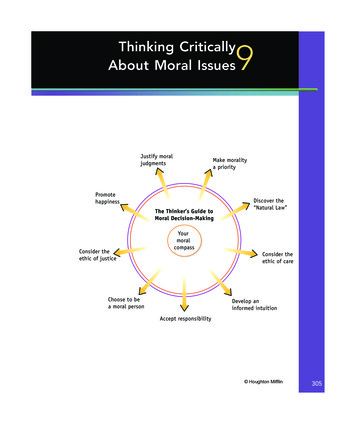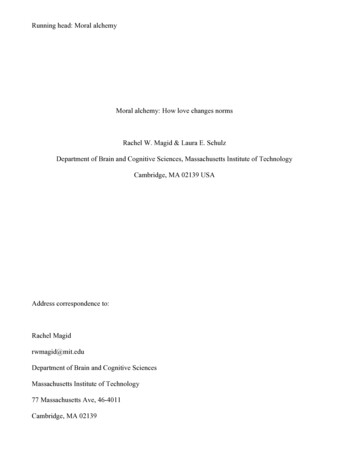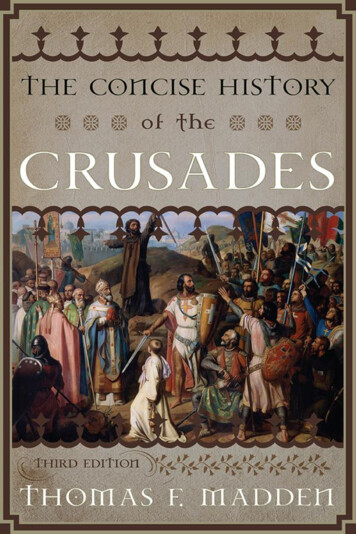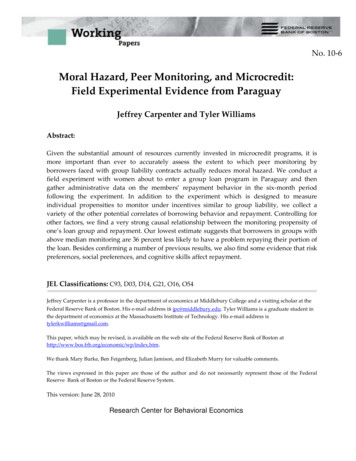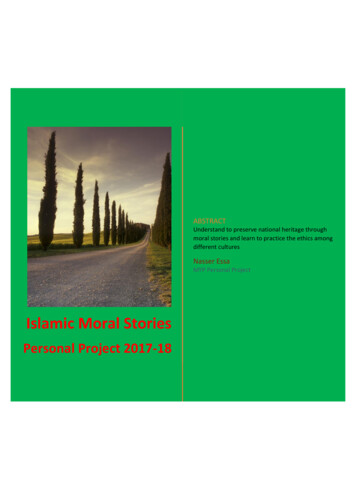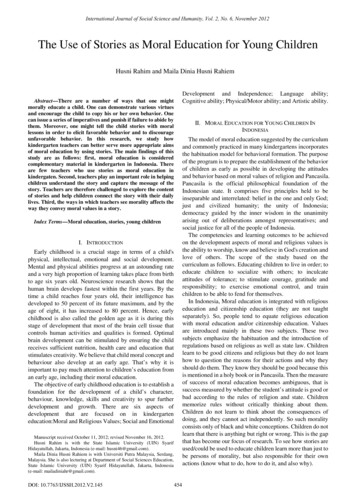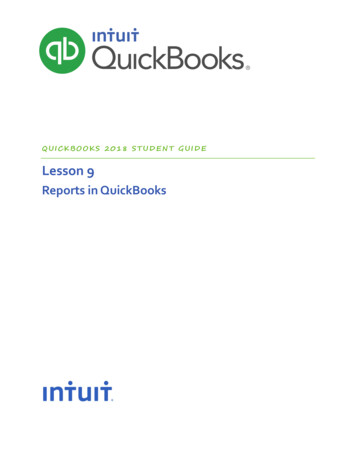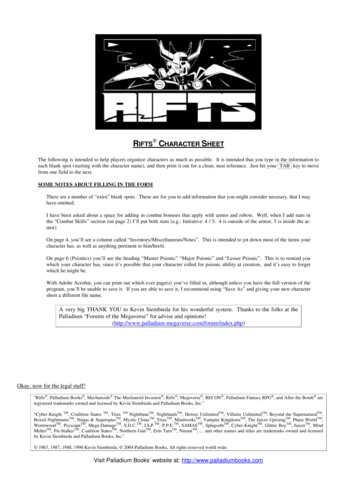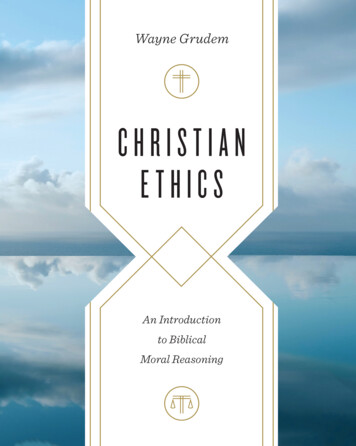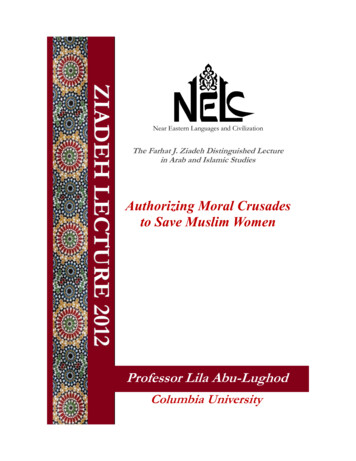
Transcription
Near Eastern Languages and CivilizationThe Farhat J. Ziadeh Distinguished Lecturein Arab and Islamic StudiesAuthorizing Moral Crusadesto Save Muslim WomenProfessor Lila Abu-LughodColumbia University
Dear Friends and Colleagues,It is my distinct privilege to provide you with a copy of the tenth FarhatJ. Ziadeh Distinguished Lecture in Arab and Islamic Studies,“A uthorizing Moral Crusades to Save Muslim W omen,” delivered byLila Abu-Lughod on April 30, 2012.The Ziadeh Fund was formally endowed in 2001. Since that time, withyour support, it has allowed us to strengthen our educational reach andshowcase the most outstanding scholarship in Arab and Islamic Studies,and to do so always in honor of our dear colleague Farhat Ziadeh, whosecontributions to the fields of Islamic law, Arabic language, and IslamicStudies are truly unparalleled.Farhat J. Ziadeh was born in Ramallah, Palestine, in 1917. He receivedhis B.A. from the American University of Beirut in 1937 and his LL.B.from the University of London in 1940. He then attended Lincoln’s Inn,London, where he became a Barrister-at-Law in 1946. In the final yearsof the British Mandate, he served as a Magistrate for the Government ofPalestine before eventually moving with his family to the United States.He was appointed Professor of Arabic and Islamic Law at PrincetonUniversity, where he taught until 1966, at which time he moved to theUniversity of Washington.The annual lectureship in his name is a fitting tribute to his internationalreputation and his national service to the discipline of Arabic and Islamic Studies. The event and publication would not be possible without thegenerous support of many contributors including students, colleagues,friends, and above all Farhat and Suad themselves, and their familymembers. On behalf of our Department, I extend my deepest thanks tothem and to all of you who have supported the Ziadeh Fund. You trulyhave made a difference!Sincerely yours,Scott B. NoegelChair, Department of Near Eastern Languages & Civilizationhttp://depts.washington.edu/nelc/
The Department of Near Eastern Languages and Civilizationat the University of WashingtonThe Tenth Farhat J. ZiadehDistinguished Lecture inArab and Islamic StudiesApril 30, 2012Authorizing Moral Crusadesto Save Muslim WomenProfessor Lila Abu-Lughod
LILA ABU-LUGHOD is the Joseph L. Buttenwieser Professorof Social Science at Columbia University. She teachesAnthropology and Women’s Studies and is currently directorof the Middle East Institute. Her scholarship, strongly ethnographic and mostly based on research in Egypt, has focusedon three broad issues: the relationship between cultural formsand power; the politics ofknowledge and representation;and the question of women’srights in the Middle East.Among her award-winningbooks are V eiled Sentiments;Writing Women’s Worlds; andDramas of Nationhood. Amember of the Center for Palestine Studies at Columbia, shehas co-edited with Ahmad H.Sa’di: Nakba: Palestine, 1948,and the Claims of Memory. Hermost recent book is Do MuslimWomen Need Saving? (HarvardUniversity Press, 2013).
Authorizing Moral Crusades toSave Muslim WomenLILA ABU-LUGHODWe seem to be living in remarkable times. A decade after women’s rights served as a respectable reason to support military intervention in Afghanistan, not only is the language of human rights on almostevery tongue, but the call for global women’s rights has gone mainstream. The abuses women suffer are no longer considered private matters or dismissed as insignificant in the international public sphere.Signs of this seismic shift are everywhere, nowhere more apparent thanin well-received books by writers in the U.S. who publish for a broadeducated public. Nicholas Kristof and Sheryl Wudunn’s Half the Sky:Turning Oppression into Opportunity for Women Worldwide, for example, is billed as “a call to arms against the most shocking and widespread human-rights violation of our age—gender inequality.”1What developments—in global institutions, culture industries,and politics—have enabled the Western public to find so convincingand plausible the sanctimonious championing of distant women by NewYork Times journalists or the fiery denunciations of Islamic patriarchyby the Somali émigré Ayaan Hirsi Ali, or even a liberal Princeton philosopher’s call to civilize Pakistani men who are waging a war on women through honor crimes?2These questions could not have been asked if Edward Said hadnot taught us how. He exposed brilliantly the connections between power and knowledge in Orientalism and I want to share with you todaysome of what his work enables us to see in this new moment of the apparent triumph of global feminism.3 I want to ask us to consider howthe architects of this new common sense about going to war for womengain such authority. And to ask why so many come to agree with theirarguments—which manufacture consent for international military andhumanitarian engagements across the Muslim world—when there areflaws in their reasoning, silences in their stories, and partiality in theirrepresentations of women’s problems. I would argue that a myth—of aplace called Islamdom inhabited by a creature called the Muslimwoman4—lies at the core of this championing of women.5
In my book Do Muslim W omen Need Saving? (which unlikeHalf the Sky will never be made into a TV movie because it flies in theface of this new common sense), I argue that such public intellectualsmake their premises unassailable by drawing on a language of humanand women’s rights that now has tremendous currency.5 This languageinsists that people around the world must learn how to be just and tomeasure up in a universal metric of humanity that is defined, in part, byaspirations for gender equality and women’s freedom.6 But if the authority for this moral crusade to rescue women in other parts of theworld depends on associating itself with the lofty language of universalrights that is embedded in a range of international institutions, its emotional persuasiveness derives from the bedrock on which such advocates build: a massively popular genre of writing about the wrongs other women suffer—particularly Muslim women. The genre is graphic,even porno-graphic.The discourse of international human rights that grounds this“common sense” depends, in other words, on another more sordid discourse. Coming from the world of mass-market commercial publishing,and surely disdained by respectable writers like these, it neverthelessunderwrites their crusade. One can identify this genre of books by theircovers. We have seen them in airport bookstores. Vron Ware noted in2004 at Heathrow Airport these books were gathered together in a section on “Eastern Studies.”7 An image of a veiled woman is paired withtitles like: Sold: One W oman’s True A ccount of Modern Slavery; Without Mercy; Burned Alive; Married by Force; Daughters of Shame; ATrue Story of Life Behind the Veil in Saudi Arabia; and even long onesreminiscent of 19th century melodrama: Disgraced: Forced to Marry aStranger, Betrayed by My Own Family, Sold My Body to Survive, Thisis My Story. They are personal stories “ as told to.”The two languages, one abstract and disinterested, the otheraffective, bleed into each other. Key to the vocabularies of both areconsent, choice, and freedom. The central drama is constructed as thedifference between those who choose and those who do not, betweenthose who are free and those who live in bondage.Although in my book I consider both of these languages, in thislecture I look only at the second, the genre whose circulation we mightthink of as a form of literary trafficking. I will analyze the political contexts in which these books are produced and reflect on how they might6
be affecting those who consume them. I will also read against the grainof their dark titillations and strange alchemy—in which the exceptionalbecomes general—to let you glimpse even in such formulaic storiesanother way of thinking about the victim/heroines who are the objectsof such intense concern. In so doing, I offer an alternative image ofMuslim women’s lives.Feminism and Pulp NonfictionWe live in an era in which the idea of universal human rightshas been broadly accepted. The very success of the institutionalizationof the concept in myriad organizations and its virtual monopoly on thehigh ground of global morality led feminists beginning in the 1980s totry to link the struggle for women’s rights and well-being to humanrights.8 Activists working in the international arena waged a successfulcampaign to declare women’s rights as human rights. They did sothrough drafting conventions, installing themselves in vast bureaucraticinstitutions, and putting in place mechanisms of accountability. If theevils of gender discrimination now seem so obvious and the language ofwomen’s rights has such authority, we have to thank these conventionsand campaigns.But if the new common sense about the urgency of battling forwomen’s rights gains authority through its association with this international consensus on the utopian high moral ground of “universal” rightswith its central value of “choosing freely,” I would argue that it drawssurreptitiously on a different discourse for its emotional appeal. A luridgenre of writing on abused women and girls—mostly Muslim—exploded onto the scene in the 1990s and took off after 9/11. Thesebooks are read in book clubs, reviewed widely, and sold enthusiastically. The recurrent and defining themes of this genre are force and bondage. At one end are gentle memoirs like Azar Nafisi’s Reading Lolita inTehran and polemics like Ayaan Hirsi Ali’s The Caged Virgin and itssequels. At the other end are books the literary scholar Dohra Ahmadhas called “pulp nonfiction.”9 Here, we are plunged into dystopicworlds of violent abuse, our guides the Muslim girls who have sufferedand escaped.As we all know, there is a long tradition of representing Muslim women in the West. Scholars call it gendered Orientalism, following the lead of Edward Said.10 Pictorial as well as literary, what is constant is that Muslim women are portrayed as culturally distinct, the mir-7
ror opposites of Western women. In the nineteenth century, the depictions took two forms: women of the Orient were either portrayed asdowntrodden victims who were imprisoned, secluded, shrouded, andtreated as beasts of burden or they appeared in a sensual world of excessive sexuality. Christian missionary women appealed for support bydecrying the oppression of their Muslim sisters in the first register. Artists and writers, and even the colonial postcard photographers of theearly twentieth century, preferred the sensual and sexual.The late twentieth- and early twenty-first-century mass-marketpaperbacks echo these themes but have their own distinct style andcharacter. Their protagonists are, as Dohra Ahmad notes, “plucky individualists” with feminist ideals who do not want to remain trapped intheir strange and sordid worlds. They want freedom, like the “nativeinformant” celebrities whose denunciations of Islam as causing the oppression of women have been so warmly welcomed and whose careershave been bolstered by powerful institutions of the Right, celebritieswhose personal stories are, as Saba Mahmood has noted, always told interms of emancipation.11Should we treat these “memoirs” as nonfiction? That is howthey are billed. Some are unreliable because they are based on repressedmemories. Many of the protagonists are known only by first names.Some books are based on “secret knowledge.” Some, such as NormaKhouri’s Honor Lost, have been exposed as hoaxes.12 Almost all thebooks are co-written with journalists or professional ghostwriters. Theyare, therefore, at the least, mediated in complex ways. To the extent thatthey may reflect real experiences or incidents, they are as disturbing asany incidents of abuse that we read about in our newspapers, legal cases, or psychology case studies of pathological behavior.But the books work hard not to let us make these comparisons.Although they are told in the first person of individual women, the traumas and abuses they catalog do not present themselves to readers asunique to these individuals. They are always contextualized by culture—the authenticating details of eking out a living on a bare mountaintop in Yemen; the exotic color of Moroccan weddings and exorcisms; the cloistered opulence of Saudi Arabian palaces; the damp cellars of Pakistani immigrant communities in the north of England; thefields of rural Palestine. The placement in these locations marks theabuses as cultural or collective. Without offering a general picture of8
the communities in which our heroines live, since these are “just” personal stories, these memoirs cannot give readers any indication thatsuch abuses might be exceptional, or might be considered as horrifyingin those communities as they would be in ours. Without this contextualinformation, we are led to attribute these abuses to the whole culture inthe selective process that Leti Volpp, the legal theorist, has called“blaming culture for bad behavior.”13Contrary to the message of uniformity that their copycat coversconvey and this cultural framing implies, to someone like me who isfamiliar with the kinds of communities or the countries in which theyare set, the stories seem radically specific. When one reads against thegrain, there are even plenty of hints that they are unsettling and exceptional, even if based on truth. Take the trilogy of memoirs beginningwith Sold that tell the terrible tale of two girls “sold” into marriage inYemen. These are daughters of a British working-class mother and aviolent, gambling Yemeni immigrant father. Although the villain is theheartless Arab man (this was pre-9/11, so Muslims had not yet becomethe obligatory enemy, and this was the moment of the Gulf War), thememoirs mention that the families who “bought” the underage brideswere from a despised group. It is remarked in passing that this is a poorcountry where three-quarters of the men leave home to look for work.Surely this must produce an unusual situation for women, not to mention the minority of men left behind.So these stories each use a peculiar situation without markingits radical specificity or lack of representativeness and without givingcontext. The result is that these best sellers that trade on images ofbondage—Zana’s Sold; its sequel, A Promise to Nadia; and their mother’s W ithout Mercy: A Mother’s Struggle against Modern Slavery—lead readers to surmise that forced marriage is normal in these communities and that women must be rescued from them by outsiders.14The genre is characterized by consistent themes: coercion andlack of consent, absence of choice, and unfreedom. To give the flavorof these works and to suggest how the peculiar play with force may affect readers, I begin with a typical scene. It is from a sequel to Sold byMiriam, the mother of the two girls and meant to explain why she hadto escape from the brutal Arab Yemeni father of her seven children. Shehas just chosen to be sterilized. Her husband comes home drunk, andshe confronts him again about her two missing daughters. He tells her9
to forget them and locks her in the room. Miriam recounts:He was close now, leaning towards me, his beery breath engulfing me. I sat, terrified, on the sofa. He came closer and held outhis hand. I slapped at it furiously, hoping he would go away.Instead he pulled me up, his good thumb and middle fingeraround my throat. I fought him off, pushing him to the floor. Hegrabbed at my dressing-gown in a vain effort to save his fall,pulling the material apart, tearing it down its length. . . . “Takeyour clothes off! All of them!” Muthana growled deeply. His eyes travelled over my body, settling on the scar fromthe operation to sterilize me. He reached out and touched thescarred flesh. I went to slap at his hand again when, suddenly, he grabbed my hand by the wrist and pulled me sharply tothe floor, rolling me over onto my back and jumping on top ofme immediately in a quick movement. I scrunched my eyesshut and clanged my fists at my side. I lay rigid on the floor ashe indulged himself, crying out in his pleasure as I cried out inmy shame.15Marital rape epitomizes absence of consent, just as does forced marriage, the practice that has captured the imagination and mobilized theefforts of women’s groups and government officials across Europe.One of its fullest treatments in “pulp nonfiction” comes from France.Married by Force by Leila (no last name) is even more graphicin its violence than Miriam’s account. The story of a troubled Frenchgirl of Moroccan parentage, the book recounts incidents of violence andterrible cruelty in the family in which Leila grows up. Her father is adisciplinarian; her brothers are abusive. She wants to be like Frenchgirls, but they won’t let her. Her parents force her to marry a man fromMorocco, a husband she hates. She has a frightening encounter with asex maniac imam hired to exorcise her because she objects. Like Zana,Sold’s heroine, Leila finally escapes her forced marriage and findsfreedom. It is then that she tells us her story.The reader is treated to some horrific scenes between husbandand wife along the way. Trying desperately to provoke him to divorceher, Leila goads and insults her husband mercilessly. This leads to aclimactic scene: Leila recounts, “One evening, at midnight, I was quietly taking a bath to relax and I’d forgotten to lock the bathroom door. He10
began to start a fight, me in the bath, him on the other side of the door,being spiteful.” They exchange insults until she reveals to him a secretabout his own mother. He calls Morocco to confirm and then is“furious, his eyes popping out of his head. ‘Bloody bitch, bloody tart,open this door!’”He charges into the bathroom and shoves her head underwater.She scratches his face. He throws her onto the floor and punches andkicks her, yelling, “Is this what you want? Here, take that and that.” Shedescribes her feelings, lying naked on the floor and being beaten, with aweirdly out-of-place metaphor meant to position this bad marriagesquarely in the specific context of Islamic barbarity: “It was the totalshame, humiliation and horror of a woman being stoned to death.”16A Pornography of Muslim BondageIn another, more fanciful book, lightened by a likable heroinewho has a weakness for whiskey and extravagant shopping at BergdorfGoodman, the theme of force is also lashed onto Middle Eastern men.Desert Royal is the fourth in a series of popular books that are presented as the first person accounts (as told to Jean Sasson) of “Sultana,” awealthy feminist Saudi Arabian princess who wishes to expose to theworld what is really going on in her society. It includes incidents thatcapture the essential unfreedom of women there. A sexual charge runsthrough it.The most sensational scene is a visit Sultana and her two teenage daughters pay to a distant cousin. They have heard rumors that hehas built a spectacular palace to replicate Paradise, and they want to seeit. Their visit is disastrous. Besides finding thousands of caged birdsthat one daughter wants to set free and takes away with her (very subtlesymbolism), they come across a pavilion that is signposted “Stallions.”Looking for horses, the other daughter discovers a “harem” of sexslaves from Asia. The young women are guarded by an exotic and gnomic Sudanese eunuch. As Sultana explains in her apparently evenhanded condemnation of patriarchy, “I knew that it was not a simple matterto come between men and their sexual desires. It is the natural inclination of many men, and not only in the Middle East, to seek out younggirls or young women as sexual conquests.”17 Yet she surmises thattheir wealthy owner wants these girls for a special cultural reason. Inhis eyes, she suggests, “these young women were like the seductivevirgins called ‘houris’ that are described in the Koran. I suspected that I11
was looking at a stage intended to provide untold delights for Faddel.Yet this must be the scene of unspeakable hell for these women heldagainst their will.”18The public appetite for such depictions of sordid and brutaltreatment of women by Muslim or Arab men is disquieting. Unlike themany good ethnographies that describe women’s everyday lives inthese countries, these “memoirs” of suffering by oppressed Muslimwomen enjoy spectacular and enduring popularity, selling millions andgoing into many editions. More disquieting is the constant reference tosex. The focus on sexual abuse has made some of the memoir writersaward-winning activists. The most amazing case is that of HannahShah, author of The Imam’s Daughter. She went public in 2009 withher gruesome story of sexual abuse by her father, an imam in NorthEngland of rural Pakistani origin. She says she speaks to gatherings of5,000.19What makes these books so appealing and their authors so celebrated when the writing is often appalling and the stories so extreme?To understand this, I think we have to place them in the contexts inwhich they are being read. These books are caught up in a charged international political field in which Arabs, Muslims, and particular others are seen as dangers to the West. The feminists who write blurbs onthe covers of these far-fetched books are often associated with rightwing and Zionist groups. The “personal letter” from Sultana that prefaces Desert Royal openly engages international politics by framing thebook as an invitation to the West: “I hope you are not weary of hearingour tragic tales, for we are gaining small freedoms here and there, andwe continue to need your attention and your support Without mediaattention and political intervention from other lands, most of our menwould be most joyous to return to a time of utter darkness for the females living in Saudi Arabia.”20That books about bad Arabs who force and enslave girls have aspecial place in the politics of European immigration is revealed by theenthusiastic reception of such books in France. Three of the classics ofthis genre were first published or publicized there: Burned A live, thememoir by “Souad” and Jacqueline Thibault of a Palestinian honor killing survivor; Sold, the book by Zana Muhsen and Andrew Crofts aboutthe girls in Yemen that became a best seller after her appearance on aprime-time French talk show; and Married by Force, by “Leila” and12
Marie-Thérèse Cuny. French anxieties about North African immigrantsare particularly intense, as these Arab Muslims form a postcolonial underclass in the restless suburbs (banlieues).21 In her study of the politicsof humanitarianism in France, Miriam Ticktin draws a real-world parallel and says it’s not surprising for a country whose then president, Nicolas Sarkozy, had dramatically offered France’s protection “to each martyred woman in the world.”22In Britain in the past decade—with troops stationed in Iraq andAfghanistan, eruptions of public hysteria about Shari’a arbitrationcourts and burqas, fears of homegrown fanaticism instigated by the 7/11bombings, and feminist agitation leading to national legislation againsthonor crimes and forced marriage—it is Pakistanis, not Arabs, whohave emerged as the new authors of these memoirs. Some of the sameghostwriters who worked with Arabs now work with them.The pornographic element of these memoirs was surprising tome. The dynamics are clearest in one published in Britain in 2009 thatmost directly challenges the authority of Islam at a time when the hysteria about family arbitration courts was at its height. The villain is a horrid imam and the heroine his daughter. Typical of its graphic scenes ofthe rape and abuse of this little girl by her father, an apparent pillar ofthe Muslim community who locks her in the cellar for his work, is thefollowing: “Dad was like a terrifying predator. I never knew when hewould strike. Once I was in the bathroom, when all of a sudden Dadjust barged in. He locked the door. . .He took down his shalwar kamizbaggy pants, and plunked himself down on the loo. He forced me towatch as he started touching himself and breathing heavily. I tried tolook away, in disgust, but he grabbed me by the hair and forced my facetowards him—so close that I could smell that horrible, musty smell thatalways made me feel so sick. Then he grabbed my hand and forced itaround his flesh.”23Here we can see most clearly how these memoirs are meant toinspire horror and pity, followed by admiration for the heroine survivors’ escapes into freedom. Freedom means escaping not just the Muslim men who torment them but their own communities and cultures.The memoirists confess their rage, self-loathing, and suicide attempts;they often describe themselves as having been rebellious teenagers.This is the feminist difference of the late twentieth century and into thetwenty-first, where brown women seem to want to be rescued by their13
white sisters and friends, to adapt Gayatri Chakravorty Spivak’s famousformulation.24 If these Muslim girls and women were not portrayed aswanting what we want—love, choice, and sexual freedom—preferringinstead to be dutiful daughters living in the bosom of their families, virgins at marriage, devoted wives partnering with their husbands, or piousindividuals seeking to live up to the moral ideals of their religion and itslaws, it would be hard for Western readers to identify. It would be hardfor publishers to find such eager audiences if they offered us womenand girls who challenged our assumptions about what they should wantand what is good for them. Western women would no longer be the rolemodels, nor would they feel needed. Interestingly, this freedom is notnecessarily presented as secular. I found Shah’s The Imam’s Daughteradvertised on a website called ChristianBooks where it was describedas “a true story of a courageous woman who broke free of cultural oppression and embraced a new life in Christ . . . She married who shewanted. An amazing account of God’s saving grace.”25The only pious women who appear in this genre of “oppressedMuslim women” stories are the hapless victims, grievously betrayed bytheir silent God, who appear in the most extreme and controversial examples. The mobilization of the pornography of bondage for antiimmigrant European politics is best seen in a short film that actuallybreaks with the conventions of faux-cultural and individual specificityof this dystopic genre. The context is the Netherlands in 2004. The writer is Ayaan Hirsi Ali. The work in question is the eleven-minute filmcalled Submission that catapulted her to notoriety and resulted in themurder of the film’s director, Theo Van Gogh.Hirsi Ali’s signature intellectual style of asserting direct causalconnections between decontextualized verses from the Qur’an andabuses of women she has met in shelters and her fantasies shapes thefilm. There are four characters: a woman repulsed by the husband chosen for her by her family, for whom marital sex feels like rape; a woman who must submit to beatings by a jealous but philandering husbandbecause he supports her financially; a modest veiled woman who is subjected to humiliating incest by an uncle; and a woman who fell in lovebut was abandoned by her lover and then lashed for fornication.The film implies that such abuses are sanctioned, if not directlycaused, by Islam, ignoring centuries of interpretation—exegetical, judicial, and everyday—of the Qur’anic verses in question, and silent on the14
abhorrence of rape or incest in the Islamic legal tradition, not to mention all Muslim societies. And its pornographic visuals Annelies Moorshas captured perfectly by calling the film “hard core Orientalism.”26If we want to appreciate the allure of this genre, I think we mustconfront this pornographic aspect. With Marcus Wood, the scholar whohas analyzed what he calls plantation pornography, we might want toask, what are the effects of a genre of pornography—with its objectification of subjects and its depiction of violence, sexual force, and bondage—when it is tied to a racial politics and a legacy of colonial or racialdomination? Wood looks at the role of eighteenth- and nineteenthcentury British writings and pictures, often placed in the context of abolitionist literature, that depict the abuse of black bodies in the Atlanticslave trade, noting how it overflows into the present as “a huge business” that has infiltrated literature, fine art, popular publishing, film,video, and bondage and discipline, sado-masochism cultures on theweb.27Wood shows how central this pornographic genre is to the misrepresentation of slavery. His reading of John Gabriel Stedman’s 1790classic text Narrative of a Five Y ears Expedition against the RevoltedNegroes of Surinam reveals a troubling double effect: the way his attitude constantly shifts “between a shrill moral outrage and a series ofattempts to emotionally bond with the slave victims by attempting toappropriate their pain in order to demonstrate his own sensitivity.”28We find a similar moral outrage in the pulp nonfiction about theMuslim woman or girl, incited (and, perhaps, excited) by the violationsand violence of sex. But given the women authors (all “lapsed” Muslims) and the intended audience (largely female and perhaps mostly non-Muslim), we can see a slightly different dynamic of identification andappropriation of pain put into play.Western readers find these sensationalist books grippingenough to buy them in the millions and their identification with Muslimwomen victims may be a feminist one, which gives it a slightly different dynamic than the strangely mediated empathy of the slaver or exslaver with the abused slave woman victim that was found in late eighteenth-century works or circulated in the abolition literature. I think wecan see that these books produce a horror that underwrites a confidentsense of moral disti
Apr 30, 2012 · J. Ziadeh Distinguished Lecture in Arab and Islamic Studies, “Authorizing Moral Crusades to Save Muslim Women,” delivered by Lila Abu-Lughod on April 30, 2012. The Ziadeh Fund was formally endowed in 2001. Since that time, with your support,
